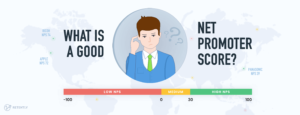Table of Contents
High NPS scores can definitely feel like a big win. After all, Net Promoter Score is a popular way to gauge how happy your customers are and how likely they are to recommend your business to others. It’s a straightforward metric that many businesses use to celebrate their customer satisfaction.
But here’s the catch: a high NPS doesn’t always mean everything is going perfectly. It’s easy to assume that a soaring score means your business is hitting all the right notes, but that might not always be the case. Sometimes, a high NPS score can be misleading and give you a skewed view of customer satisfaction.
In this article, we’ll explore why a high NPS score might not always mean success and what other factors you should consider to truly understand how your customers feel.
Key Takeaways
- A high NPS can be misleading due to several factors, including low response rates, ambiguous data or selection bias.
- Running recurring NPS campaigns helps capture evolving customer experiences and provides a more complete view of customer loyalty.
- Measuring NPS should be just a part of your overall CX strategy, not the sole focus.
1. Low Response Rate
When you see that high NPS score, it’s easy to assume you’ve secured a loyal base of happy customers. But here’s a key detail to watch out for: response rate. If only a small percentage of your customers are filling out your NPS survey, it could seriously affect the reliability of those glowing results. As a matter of fact, research shows that surveys with response rates below 20% often miss a true representation of the customer base.
Imagine you send out your NPS survey to 1,000 customers, but only 50 people respond. That’s a tiny slice of your customer base influencing the score, which cannot reflect the broader customer experience.
So why does this matter? An inflated NPS score from a small, unrepresentative sample can give you a false sense of security. If you’re only hearing from a select few, you might miss out on valuable feedback from the majority. This means you could be overlooking issues or areas for improvement that are affecting the broader customer base.
Takeaway: To avoid this pitfall, it’s important to work on increasing your response rate. This way, you’re more likely to get a balanced view of how your customers feel. Start with a straightforward survey process. Focus on essential questions – the NPS rating question and a few targeted open-ended questions – to make it easier for customers to complete. Additionally, make sure your surveys are mobile-friendly for on-the-go feedback. A higher response rate makes your NPS score a more trustworthy indicator of overall customer satisfaction.
2. Snapshot vs. Long-Term Perspective
Think of NPS as taking a quick photo of your customer’s feelings at a single moment in time. It’s a snapshot that captures how they felt about your product or service after a specific interaction or experience. While this can give you a valuable glimpse into their reactions, it doesn’t tell you the whole story.
The main issue with relying solely on this snapshot is that it doesn’t account for changes over time. NPS doesn’t provide a long-term view of customer satisfaction if used as a one-time survey. You might get a high score today, but that doesn’t guarantee your customers will feel the same way 3 months from now.
For example, if your customers were thrilled after they completed their onboarding but you don’t check in with them again, you might miss out on whether their satisfaction remains high or if issues arise later. Without recurring follow-ups, you risk overlooking long-term trends or emerging problems that could affect customer loyalty. What’s more, businesses that consistently engage with customer feedback achieve significantly higher revenue growth.
Takeaway: The lack of recurring follow-ups means you’re missing out on deeper insights into how consistent your customer satisfaction is. NPS is an ongoing process, not a one-time survey. Regularly engaging with your customers and tracking their feedback over time can give you a more comprehensive view. This helps you understand if your high NPS is a temporary high or if it reflects sustained customer happiness.
3. Ambiguous Open-Ended Comments
High NPS scores often come with a flurry of open-ended comments, but these can sometimes feel like trying to read between the lines. When customers leave vague feedback like “Great service!” without specifics, it’s difficult to understand what truly made their experience positive. While a high NPS indicates general satisfaction, these ambiguous comments don’t provide the detailed insights you need to fully grasp what’s working and what isn’t.
Ambiguous feedback is a double-edged sword: it confirms that customers are happy but leaves you guessing about the reasons behind their satisfaction. This lack of detail can result in an incomplete understanding of your customer experience.
This is where NPS specialized tools come into play. These can perform advanced text analysis, allowing you to dig deeper into the open-ended comments. By automatically categorizing and analyzing feedback, these tools help you identify common themes and patterns that might otherwise go unnoticed.
For example, they can highlight frequently mentioned keywords or sentiments, giving you a clearer picture of what customers truly value and where there might be room for improvement. Instead of just celebrating a high NPS score, you can use these insights to refine your customer experience and address any hidden issues.
Takeaway: Ambiguous comments can cloud your understanding of customer sentiment. Leveraging NPS specialized tools for feedback analysis can turn vague feedback into actionable insights, helping you make informed decisions that go beyond the surface of your NPS score.
4. Selection Bias
Think about who might be more likely to leave feedback. Often, it’s the customers who have strong opinions – either extremely happy or very dissatisfied – who are most motivated to share their thoughts. This means that middle-ground customers, or Passives, might not be participating as much, leaving their feedback unvoiced. This can create a bit of a selection bias in your NPS results.
When only certain types of customers respond, the overall picture is skewed. For instance, if your most loyal and enthusiastic customers are the ones filling out the surveys, their positive experiences might not reflect the average satisfaction level of your entire customer base. Similarly, if dissatisfied customers – your Detractors – are not responding, their concerns are left unvoiced.
To address this bias, make your surveys more accessible and engaging for all customers. According to Salesforce, personalizing invitations – addressing customers by name and referencing recent interactions – can boost participation by 29%. Offering incentives like discounts or prize draws can also help out if managed carefully to avoid further skewing results. Actually, companies with consistent NPS scores, like Apple, Airbnb and Amazon successfully use this trick to leverage all NPS customer segments.
Most importantly, closing the feedback loop and communicating the resulting changes to customers can show commitment to customer success and encourage even more participation.
Takeaway: To get a more accurate picture, it’s important to encourage a wider range of customers to participate in your surveys. This includes reaching out to those who may not be as vocal – for example your Passives – but whose feedback is just as important. By addressing this bias, you can better understand customer satisfaction and make improvements that truly reflect the needs and concerns of your entire audience.
5. Customer Experience Variability
Customer experiences can vary widely based on factors like the time of day, the specific service representative they interacted with, or even the product they received. This can lead to high NPS scores that may not accurately reflect the overall quality of your service if they’re based on a few exceptional interactions or periods of outstanding performance. While these high scores can be encouraging, they might not represent the day-to-day reality for all your customers. Some may receive a better experience than others, which can artificially inflate your NPS.
Similarly, when you roll out new features, run promotions, or make other changes, you might see a quick spike in NPS as customers react positively to these initiatives. However, this initial excitement might not last, especially if the changes don’t address deeper, underlying issues. Over time, if the experience returns to the norm, your NPS could drop back down to previous levels.
To get a true sense of how well you’re doing, it’s important to monitor your NPS over time and segment the feedback by factors like campaigns, customer demographics, and buying habits. This helps you connect any spikes in your scores to specific changes and understand which customer groups are responding positively. For instance, feedback from a particular promotion might show that it was a big hit with younger customers or frequent buyers – but did it have the same effect across the board?
Takeaway: By combining ongoing NPS tracking with detailed segmentation, you can have a more accurate understanding of how different changes – whether it’s a new feature, a special offer, or just day-to-day service – are impacting customer loyalty. This way, you’re not just chasing temporary boosts in satisfaction, but are instead building long-term relationships that stick around across all customer groups.
6. Focus on a Single Feedback Source
NPS is a useful tool, but it’s just one piece of the puzzle. If you focus exclusively on this single metric, you might miss out on other critical aspects of customer experience. It’s important to combine NPS with other metrics and sources of feedback. Consider using additional metrics like Customer Satisfaction Scores (CSAT), Customer Effort Scores (CES) and leverage in-depth qualitative feedback to get a more rounded picture.
Additionally, expanding your feedback collection across multiple survey channels – such as email, SMS, and in-app – can significantly improve your data. For instance, SMS surveys boast a 98% open rate, making them highly effective for customer engagement. Emails remain popular, with 58% of people checking their inboxes first thing in the morning, while in-app notifications can boost survey interaction by up to 30% as users engage directly within the app.
Takeaway: By integrating multiple metrics and feedback channels, you can gain a deeper understanding of your customer experience and identify specific areas for improvement. This approach helps ensure that you’re not just seeing a surface-level score but are truly addressing all aspects of customer satisfaction.
Conclusion
So, while a high NPS score is a reason to celebrate, it’s important to look beyond the surface. Here’s a quick recap of why a high NPS might not always be as positive as it appears:
- Low Response Rate: If only a small fraction of customers are giving feedback, your NPS might not truly represent the overall sentiment.
- Snapshot vs. Long-Term Perspective: If used as a one-time survey, NPS provides a transactional snapshot, which doesn’t account for changes in customer sentiment over time.
- Ambiguous Open-Ended Comments: Vague comments don’t give you clear insights into what’s driving the high scores.
- Selection Bias: Only certain types of customers might be responding, leading to skewed results.
- Customer Experience Variability: Inconsistent experiences can make a high NPS seem misleadingly positive.
- Focus on a Single Feedback Source: Relying solely on NPS doesn’t give a complete picture of customer satisfaction.
Take a closer look at how you’re using NPS in your business. Evaluate your methods and explore additional feedback tools to ensure you’re capturing a true and comprehensive view of customer sentiment. By integrating various customer satisfaction metrics and feedback channels, you’ll be better equipped to understand your customers and make meaningful improvements.
Make NPS part of a broader feedback system with Retently. Test it in a free trial and start transforming customer insights into growth!





























 Alex Bitca
Alex Bitca 


 Greg Raileanu
Greg Raileanu 

